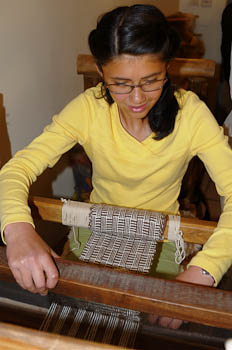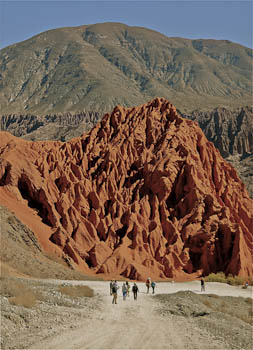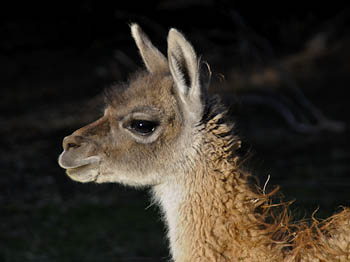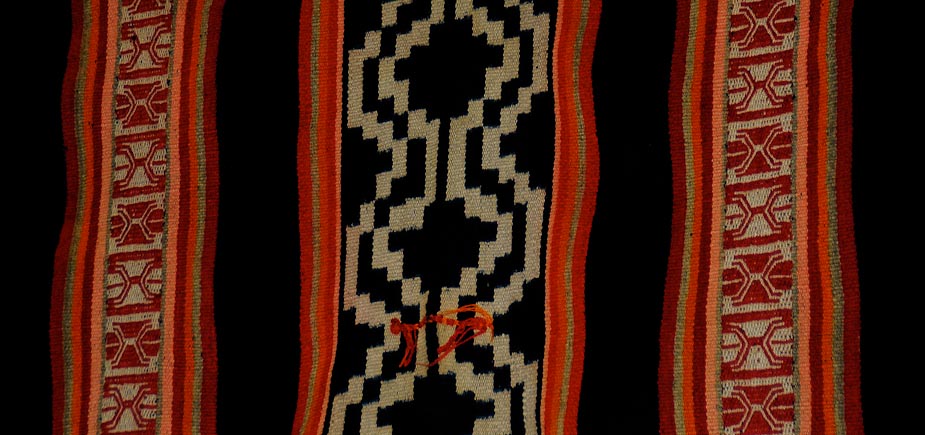WEAVING ANDEAN STORIES:
TRACING ARGENTINA’S CULTURAL HERITAGE
AND TEXTILE TRADITIONS
November 12-28, 2011
17 Days/ 16 Nights
Carol Passera, Fran Enright, Debb Tewell, Marta Valdiviezo, and Local Artisans
 Andean textiles reflect the fabric of life—a unique
heritage of woven stories and cultural traditions
inspired by the windswept steppes and snow-
capped peaks of the Andes. In the ancient Andean
world, textiles served as a primary form of artistic
expression as well as a powerful visual medium
for portraying nature’s secrets and the order of the
universe. Andean textiles are known worldwide
for their exquisite quality, intricate designs, and
rich color palette. This unique workshop explores
both natural and cultural history, wild fiber usage,
and the textile traditions of two strikingly different
regions in Argentina. Artisans in both areas
will provide instruction and share their distinctive
techniques for spinning and weaving. In the spirit
of cultural exchange, we’ve been invited to teach
felting techniques to local artisans who wish to
add new fiber skills to their creative repertoire. Andean textiles reflect the fabric of life—a unique
heritage of woven stories and cultural traditions
inspired by the windswept steppes and snow-
capped peaks of the Andes. In the ancient Andean
world, textiles served as a primary form of artistic
expression as well as a powerful visual medium
for portraying nature’s secrets and the order of the
universe. Andean textiles are known worldwide
for their exquisite quality, intricate designs, and
rich color palette. This unique workshop explores
both natural and cultural history, wild fiber usage,
and the textile traditions of two strikingly different
regions in Argentina. Artisans in both areas
will provide instruction and share their distinctive
techniques for spinning and weaving. In the spirit
of cultural exchange, we’ve been invited to teach
felting techniques to local artisans who wish to
add new fiber skills to their creative repertoire.
In Argentina, the first hand-spun cordage—a mixture of plant fibers, wool, and human hair—
dates to nearly 7670 BC and was found in a cave
in Jujuy Province. Where did the wool-like fiber
come from? The Camelidae Family made its first
appearance in North America about 35 million
years ago. The radiation of a single species of
Camelid to South America and Asia occurred 3
million years ago. In South America, this species
evolved into the guanaco (wild progenitor of the
llama) and the vicuña (wild progenitor of the
alpaca). Both the llama and the alpaca are the
result of the domestication and selective breeding
of their wild progenitors by pre-Incan cultures
beginning at least 6,500 years ago. With the Inca’s
ascendency, woven cloth became such a valuable
commodity that it often served as a status symbol
or as a form of currency. The Spanish  conquerors,
discovering indigenous populations already
skilled in the art of weaving, introduced European
merino sheep, increased native cotton cultivation,
and imposed strict textile guidelines and religious
strictures on the weavers. Spanish textile designs
and influences can still be seen in northwestern
Argentina, but indigenous cultural traditions and
artistic expression persists—virtually unchanged. conquerors,
discovering indigenous populations already
skilled in the art of weaving, introduced European
merino sheep, increased native cotton cultivation,
and imposed strict textile guidelines and religious
strictures on the weavers. Spanish textile designs
and influences can still be seen in northwestern
Argentina, but indigenous cultural traditions and
artistic expression persists—virtually unchanged.
Our textile odyssey begins in Buenos Aires, with
visits to museums and lectures by noted textile
experts. We’ll fly to Jujuy, in the heart of Nor
Oeste Argentino, and then drive along the historic
Camino Inca, through the cardón cactus-dotted
foothills of the Andes, to the highland village of
Purmamarca. Incan and Hispanic influences
remain strong and vibrant throughout the region.
We’ll visit the partially restored ruins of Pucará de
Tilcara, one of four pre-Inca villages built to
guard the trade route along the Quebrada de
Humahuaca. The region’s most accomplished
weaver and teacher, Marta Valdiviezo, will join us
at our unique adobe lodge, Hosteria del Amauta.
Marta will share the spinning and weaving traditions
of the highlands, as well as show us how to
dye with native plants. We’ll travel the painted
desert canyons of the Quebrada de Humahuaca,
exploring the vast salt flats of Salina Grande and
stopping at the village of Cochinoca. There will
be opportunities to visit colorful artisan markets
and galleries to purchase alpaca wool and textile
treasures—inspiration for our own fiber work!
View Larger Map
The beautiful colonial city of Salta, which serves
as a cultural center for the textile arts of Northwest
Argentina, is also home to the world-famous
Museum of High Altitude Archaeology—a unique
window into the Inca world. We’ll view the
mummified, hauntingly beautiful remains of three
Inca children sacrificed in accordance with Inca
rituals honoring Mama Huaco, the Inca ancestor
who introduced them to maize. In 1999, archaeologists
excavated the remains of two girls and a
boy from a subterranean burial shrine near the
summit of Volcán Llullaillaco. The "chosen
ones" seemed at peace, each adorned in exquisitely
woven clothing and accompanied by
perfectly crafted miniatures of the tools and other
goods that would be needed in the next world. To
the Inca, the highest peaks in the Andes were the
"guardians" of their world. Of the 200 peaks
known to have archaeological remains, 40 are located
within the Province of Salta.
 Shifting our focus to Patagonia, we’ll travel to the heartland of the indigenous Mapuche people. The
Mapuche developed their own weaving style,
exemplified by double-faced textiles with complicated
geometric designs. We’ll visit several
artisan markets, where Mapuche women still
gather to spin, weave, and sell their work. From
our lodgings at Mirador Huancache, near the
Mapuche village of Gualjaina, we’ll travel along
the Chubut River and explore beautiful Cañadon
de la Buitrera and Piedra Parada. We’ll visit the
Mapuche weaver's cooperative at Cushamen—
where we’ll learn to spin and weave in the
Mapuche manner. We’ll visit the Guenguel
Project, at Estancia Don Jose, where luxurious
fabrics and garments are being made from yarns
that blend the finest quality Merino wool with that
of domesticated guanacos. We conclude with a
visit to the world-famous Cañon del Rio Pinturas
and Cueva de las Manos ("Cave of the Hands"),
where hundreds of prehistoric, brightly-colored
hand prints and pictographs of humans and
guanacos decorate the cave’s walls—a celebration
of ancient Andean artistic traditions! Shifting our focus to Patagonia, we’ll travel to the heartland of the indigenous Mapuche people. The
Mapuche developed their own weaving style,
exemplified by double-faced textiles with complicated
geometric designs. We’ll visit several
artisan markets, where Mapuche women still
gather to spin, weave, and sell their work. From
our lodgings at Mirador Huancache, near the
Mapuche village of Gualjaina, we’ll travel along
the Chubut River and explore beautiful Cañadon
de la Buitrera and Piedra Parada. We’ll visit the
Mapuche weaver's cooperative at Cushamen—
where we’ll learn to spin and weave in the
Mapuche manner. We’ll visit the Guenguel
Project, at Estancia Don Jose, where luxurious
fabrics and garments are being made from yarns
that blend the finest quality Merino wool with that
of domesticated guanacos. We conclude with a
visit to the world-famous Cañon del Rio Pinturas
and Cueva de las Manos ("Cave of the Hands"),
where hundreds of prehistoric, brightly-colored
hand prints and pictographs of humans and
guanacos decorate the cave’s walls—a celebration
of ancient Andean artistic traditions!
Price: $5,250 (includes a $1,000 deposit)
Group Size: 16
Trip Rating: 2
Price Includes: all lodging, all meals, transportation by van or small bus, lectures and demonstrations by local experts and artisans, entrance fees to museums/exhibits, naturalist guides and fiber artists, and airport/hotel transfers.
Does not include roundtrip airfare to and from Buenos Aires (11/12-13 & 11/27-28) from your point of departure, internal flights as required (TBA), alcoholic beverages, or personal items.
|
